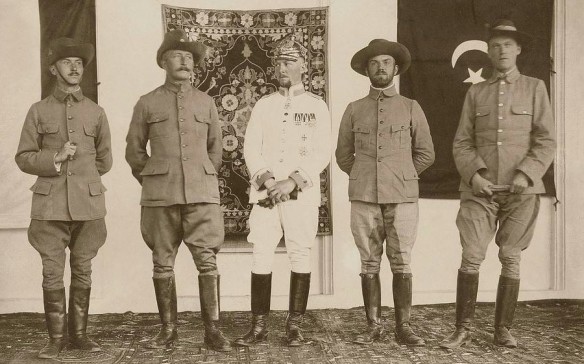German Representatives of the Afghan Mission, Kabul 1915
From left to right they are Leutnant Günther Voigt, Kapitänleutnant d.R Kurt Wagner, Leutnant Werner von Hentig, Oberleutnant Oskar Niedermayer and Walter Röhr. Except for von Hentig, they all wear the 1907 Landespolizei tunic, riding breeches and Südwester hat. Note Voigt’s yellow metal Imperial crown badge can clearly be seen on the right side of his hat, while Wagner’s cockade can be seen at the front of his. Niedermayer’s hat is not pinned up at the side but his Imperial crown badge can still be seen attached to the underside of the brim.
The Hentig-Niedermayer Expedition was planned by the German General Staff in August 1914, with the objectives of stirring up a revolution in British India, encouraging Afghanistan to attack India, and securing Iran as a link between the Ottoman Empire and Afghanistan. Werner Otto von Hentig was a diplomat who had served in Iran, and Oskar von Niedermayer was a captain in the German army; the rest of the expeditionary group comprised a Turkish officer, two Indian revolutionaries, and a number of Pashtuns released from a prisoner-of-war camp. Hentig was charged with forming an alliance with Afghanistan and establishing diplomatic relations, whereas Niedermayer was to pursue military cooperation backed by messages from the Sultan Caliph and the Ottoman government. The Indian revolutionaries were present to obtain Amir Habibullah’s support for a fight against the British in India.
The expedition arrived overland from Iran, reaching Kabul in September 1915. The amir, although loyal to the Sultan Caliph, was well aware of the British position in India and unwilling to risk an all-out confrontation with no guarantee of success, so he initialed an agreement whose military and financial demands could only be met if Germany won World War I. In May 1916, the expedition came to an end. Hentig returned to Germany through China and the United States, and Niedermayer returned through Iran and the Ottoman Empire and resumed his service in the German army. Although the expedition did not achieve its real objectives, it marked the first diplomatic contact between Afghanistan and Germany and the end of the British monopoly over Afghanistan’s external affairs.
AMIR HABIBULLAH, (1871-1919)
Amir Habibullah was a son of Amir Abdur Rahman and was born during his father’s period of exile in Samarkand on 21 April 1871. During the reign of his father, he was actively involved in the administration and was generally popular due to his competence and because he was thought to be more lenient than his father.
He took the throne on 3 October 1901 and began his rule with some positive actions, which included raising the pay of the army, recalling exiles, promising reforms, and releasing prisoners. How- ever, this approach was short-lived, as he soon resorted to his father’s policy of severe punishments and confiscation of property and he became less interested in the affairs of state. The British government tried to renegotiate some of the agreements reached with Amir Abdur Rahman and attempted to maintain that these had been personal agreements, not accords reached with the state of Afghanistan. Under extreme pressure from the British India government, Habibullah refused to yield, and after two years of stalemate, the foreign secretary of the government of India, Louis W. Dane, went to Kabul to negotiate and eventually had to accept the amir’s position. As a result, the agreements were renewed, and Britain agreed to recognize Habibullah as king of Afghanistan and its dependencies.
Habibullah was a good Muslim but began to adopt Western ways following a visit to India in 1907. This change, together with his adoption of freemasonry, led to a sharp decline in his popularity. During his visit to India, the amir found out about the Anglo-Russian Convention of 1907, which divided Iran and Afghanistan into spheres of influence between the two states, but Habibullah refused to ratify the convention, which was never implemented. Some reforms were effected during his reign, including the establishment of modern schools, the import of cars, a road-building program, and the introduction of electricity in Kabul.
The outbreak of World War I caused a further strain in Anglo-Afghan relations. In defiance of the wishes of the viceroy of India, Habibullah received the Hentig-Niedermayer Expedition at Kabul-a German expedition designed to foment unrest in British India during the war. A secret treaty of friendship and military assistance was concluded with Germany, in the event of an Allied defeat in the war, but Germany could not fulfill its part of the bargain, and Britain promised the amir a substantial reward if Afghanistan remained neutral. As a result, the amir decided to keep Afghanistan out of the war, but Britain did not fully respect his actions and endeavored to reassert its control over Afghanistan at the conclusion of hostilities with Germany.
However, certain factions in the amir’s court felt that he had failed Afghanistan. They believed World War I had provided an ideal opportunity to secure complete independence from Britain-an opportunity he failed to exploit. As a consequence, conspiracies were formed to remove him from power, and he was assassinated on 20 February 1919 in Kala Gosh, Laghman Province, while on a hunting trip.
References Vogel, Renate. 1976. Die Persien und Afghanistan expedition: Oskar Ritter Von Niedermayer, 1915-16. (The Persian and Afghanistan expedition: Oskar Ritter Von Niedermayer, 1915-16).Osnabruck, Germany: Biblio-Verlag. Gregorian, Vartan. 1969. The Emergence of Modern Afghanistan: Politics of Reform and Modernization, 1880-1946. Stanford, CA: Stanford University Press.
